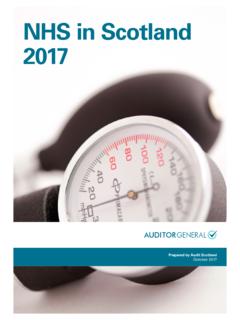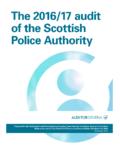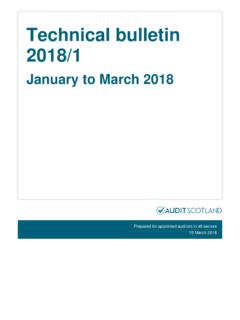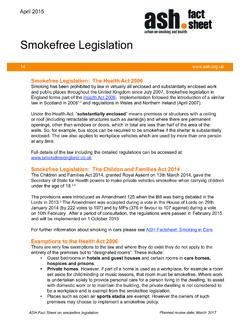Transcription of Health Inequalities in Scotland
1 Health Inequalities in ScotlandPrepared for the Auditor General for Scotland and the Accounts CommissionDecember 2012 Audit Scotland is a statutory body set up in April 2000 under the public Finance and Accountability ( Scotland ) Act 2000. It provides services to the Auditor General for Scotland and the Accounts Commission. Together they ensure that the Scottish Government and public sector bodies in Scotland are held to account for the proper, efficient and effective use of public Accounts CommissionThe Accounts Commission is a statutory, independent body which, through the audit process, requests local authorities in Scotland to achieve the highest standards of financial stewardship and the economic, efficient and effective use of their resources. The Commission has four main responsibilities: securing the external audit, including the audit of Best Value and Community Planning following up issues of concern identified through the audit, to ensure satisfactory resolutions carrying out national performance studies to improve economy, efficiency and effectiveness in local government issuing an annual direction to local authorities which sets out the range of performance information they are required to Commission secures the audit of 32 councils and 45 joint boards and committees (including police and fire and rescue services).
2 Auditor General forScotlandThe Auditor General for Scotland is the Parliament s watchdog for helping to ensure propriety and value for money in the spending of public funds. She is responsible for investigating whether public spending bodies achieve the best possible value for money and adhere to the highest standards of financial management. She is independent and not subject to the control of any member of the Scottish Government or the Parliament. The Auditor General is responsible for securing the audit of the Scottish Government and most other public sector bodies except local authorities and fire and police following bodies fall within the remit of the Auditor General: directorates of the Scottish Government government agencies, eg the Scottish Prison Service, Historic Scotland NHS bodies further education colleges Scottish Water NDPBs and others, eg Scottish Enterprise.
3 ContentsHealth Inequalities in Scotland 1 SummaryKey factsPage 2 Background Page 3 About the audit Key messages Page 4 Key recommendations Page 5 Part 1. Health Inequalities in ScotlandPage 6 Key messages People in deprived areas have lower life expectancy Page 7 Children in deprived areas have poorer Health Page 8 There is a mixed picture of progress in tackling Health Inequalities Page 10 Part 2. SpendingPage 15 Key messagesOverall NHS and council funding formulae take account of deprivation and local needsIt is not clear how resources are targeted within local areasAround 170 million was allocated to the NHS in 2011/12 for schemes related specifically to Health Inequalities Page 16 Changes in payments to GPs have led to more funding to deprived areas Page 18 Recommendations Page 20 Part 3.
4 Local Health servicesPage 21 Key messagesBetter access to Health services is needed to reduce Health inequalitiesPage 22 Recommendations Page 26 Part 4. EffectivenessPage 27 Key messagesA range of factors can help to reduce Health Inequalities Many organisations are involved in trying to reduce Health inequalitiesBetter partnership working is needed Page 28 There is limited evidence to date of the impact of national policies and strategies Page 32 Some specific interventions have reduced Health Inequalities but better evidence about cost effectiveness is needed Page 33 Performance measures should provide a clearer picture of progressPage 34 Recommendations Page 35 Appendix 1. Audit methodologyPage 37 Appendix 2. Membership of the advisory groupPage 38 Appendix 3. National strategies for improving Health and addressing Health Inequalities Page 39 Summary2 Key factsLeast deprived areas*Most deprived areasTotal amount spent by the NHS in 2011/12 allocations to the NHS for schemes related to Health Inequalities 170millionAverage life expectancy of life expectancy of hospital admissions per 100,000 population2141,621 Percentage of adults who smoke11%40%GP consultations for anxiety per 1,000 patients2862 Exclusive breastfeeding rate at 6-8 weeks40%15%* These comparisons refer to people living in the one-fifth most deprived and one-fifth least deprived are significant and long-standing Health Inequalities in Scotland .
5 The public sector can make better use of its resources to address these 3 Background1. Tackling Health Inequalities is challenging. Health Inequalities are influenced by a wide range of factors including access to education, employment and good housing; equitable access to healthcare; individuals circumstances and behaviours, such as their diet and how much they drink, smoke or exercise; and income Given the complex and long-term nature of Health Inequalities , no single organisation can address Health Inequalities on its own. Community Planning Partnerships (CPPs) are responsible for bringing all the relevant organisations together locally and for taking the lead in tackling Health Many public sector bodies and professionals contribute to reducing Health Inequalities ; it is not just the responsibility of Health services.
6 Councils have a major role through their social care, education, housing, leisure and regeneration services. The voluntary sector also has a role in reducing local Health Inequalities . 3. There have been long-term increases in average life expectancy in Scotland and considerable improvements in overall Health . However, there are still significant differences in life expectancy and Health depending on deprivation, age, gender, where people live, and ethnic group. More data is available about the links between deprivation and Health Inequalities so we are able to provide more comment on deprivation in this Reducing Health Inequalities will help increase life expectancy and improve the Health of people in disadvantaged groups. It could also bring considerable economic benefits. For example, if the death rate in the most deprived groups in Scotland improved then the estimated average economic gains would be around 10 billion (at 2002 prices); and if the death rate across the whole population fell to the level in the least deprived areas, the estimated economic benefit for Scotland could exceed 20 These are conservative estimates as they relate only to differences in life expectancy and do not include other Health Tackling the problems most commonly associated with Health Inequalities would also help to reduce the direct costs to the NHS and wider societal costs.
7 For example, the Scottish public Health Observatory has estimated that a one per cent reduction in smoking prevalence would save around 540 lives a year; reduce smoking -attributable hospital admissions by around 2,300; and reduce estimated NHS spending on smoking -related illness by between 13 million and 21 In 2007, the Scottish Government established a Ministerial Task Force for Health Inequalities to identify and prioritise practical actions to reduce the most significant and widening Health Inequalities . The Task Force published its report, Equally Well, in June 2008. This considered the evidence for Health Inequalities in Scotland and identified a range of priorities where action is most needed to tackle Health Inequalities , including: children s early years; tackling poverty and increasing employment; physical environments and transport; and access to Health and social care services.
8 The report also included recommendations for the Scottish Government, NHS boards, councils and other public sector bodies. The Task Force published a review of Equally Well in 2010 which examined progress since the publication of Equally Well and made more recommendations for addressing Health Inequalities . The Task Force reconvened in November Reducing Health Inequalities has been a priority for successive governments in Scotland with the introduction of major legislation supporting this aim, such as the ban on smoking in public places and minimum pricing for alcohol. The Scottish Government s 2012/13 spending review reiterated its commitment to addressing Health Inequalities , and in 2011/12 it allocated around 170 million to NHS boards to directly address Health -related issues associated with Shifting resources from dealing with the consequences of Health Inequalities to effective early intervention and access to preventative services is essential to tackling Health The Scottish Government s policies prioritise preventing social problems rather than reacting to them but our previous work has highlighted that shifting resources will be challenging for the public sector, particularly in the current financial 8 91 The Spirit Level, R Wilkinson and K Pickett, Bloomsbury Press.
9 All council areas have a CPP to lead and manage community planning. CPPs are required to engage with communities, report on progress, and publish information on how they have implemented their duties and how outcomes have improved as a result. CPPs are not statutory committees of a council, or public bodies in their own right. They do not directly employ staff or deliver public These estimates are based on a pro-rata comparison with estimates produced for the Marmot Review of Health Inequalities in England ( The economic benefits of reducing Health Inequalities in England and Wales , S Mazzucco, S Meggiolaro and M Suhrcke, background paper for the Marmot Review, January 2010).4 ScotPHO smoking Ready Reckoner 2011 Edition, Scottish public Health Observatory, June Scottish Spending Review 2011 and Draft Budget 2012-13, Scottish Government, September Equally Well, Scottish Government, 2008; Equally Well Review 2010, Scottish Government, 2010; Fair Society, Healthy Lives, Marmot Review, Report on preventative spending, Scottish Parliament Finance Committee, Report of the Commission on the future delivery of public services, Review of Community Health Partnerships, Audit Scotland , 2011; Commissioning social care, Audit Scotland , the audit9.
10 Our audit aimed to assess how well public sector organisations are working together to tackle Health Inequalities . Given the scale and complexity of the problem, we have not examined in detail the impact of wider policies such as education, employment and housing on reducing Health Inequalities . Instead we have focused on how bodies work together to identify need, target resources and monitor their collective performance in reducing Health Inequalities . In this report, we: outline the scale of Health Inequalities and the effects on specific groups of people estimate how much the public sector spends on reducing Health Inequalities , although information on this was limited look at the quality of evaluations review how well CPPs ensure that there is a coordinated focus on Health Inequalities look at whether access to Health services is equitable for all groups within the population, particularly people living in deprived areas.


















